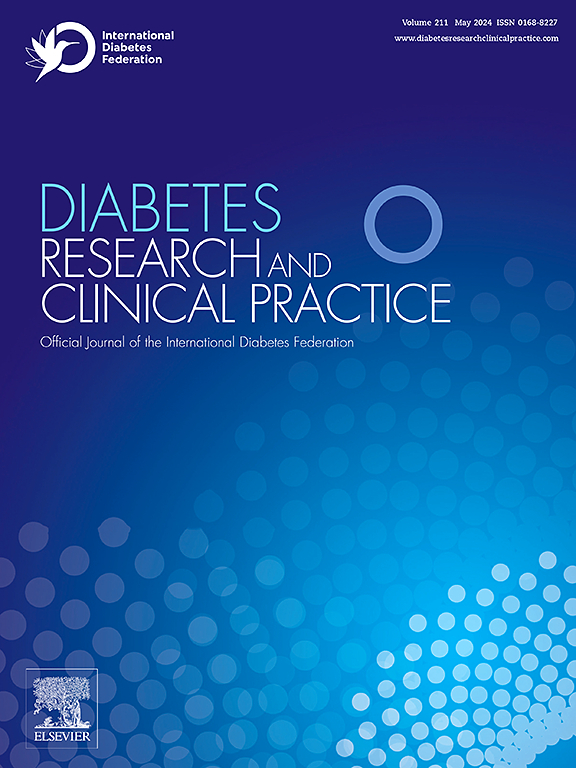高龄老人的糖尿病前期、虚弱和心血管后果之间的关系:一项全国性回顾性队列研究
IF 6.1
3区 医学
Q1 ENDOCRINOLOGY & METABOLISM
引用次数: 0
摘要
目的探讨老年人糖尿病前期、身体虚弱、心肌梗死(MI)、中风、心力衰竭(HF)和全因死亡率之间的关系。方法在2005-2006年和2014-2015年两个基线期(2007-2013年和2016-2022年)和随访期(2007-2013年和2016-2022年),对80岁以上的糖尿病前期(HbA1c 5.7%-6.4%或空腹血糖100-125 mg/dL)或血糖正常的个体进行全国性回顾性队列研究。用累积亏缺法评估虚弱程度。结果在126323名参与者中(女性61.4%,平均年龄84.1±3.7岁),34151人(27.0%)被归类为糖尿病前期患者,92172人(73.0%)被归类为基线血糖正常。在7年的时间里,13.5%的人进展为糖尿病,47.4%的人恢复到正常血糖水平,39.1%的人仍然处于糖尿病前期。非虚弱的个体比严重虚弱的个体更容易发展为糖尿病(15.0%对9.3%)。前驱糖尿病与较低的全因死亡率相关(HR 0.86, 95% CI 0.85-0.88),但与心肌梗死无关(HR 0.98, 95% CI 0.94-1.02),而与心衰(HR 1.06, 95% CI 1.03-1.09)和中风(HR 1.06, 95% CI 1.02-1.10)的风险增加相关。结论在年龄最大的老年人(80岁以上)中,糖尿病前期与全因死亡率降低相关,但与心衰和卒中的风险略有增加相关。虚弱调节前驱糖尿病的进展,不虚弱的人更容易患糖尿病。本文章由计算机程序翻译,如有差异,请以英文原文为准。
Association between prediabetes, frailty, and cardiovascular outcomes in the oldest old: A retrospective nationwide cohort study
Aims
To investigate the association between prediabetes, frailty, and the risk of myocardial infarction (MI), stroke, heart failure (HF), and all-cause mortality in the oldest old.
Methods
A nationwide retrospective cohort study of individuals aged 80+ classified as prediabetic (HbA1c 5.7%–6.4% or impaired fasting glucose 100–125 mg/dL) or normoglycemic during two baseline periods (2005–2006 and 2014–2015) and follow-up (2007–2013 and 2016–2022). Frailty was assessed using the cumulative deficit method.
Results
Among 126,323 participants (61.4% females, mean age 84.1 ± 3.7 years), 34,151 (27.0%) were classified as persons with prediabetes and 92,172 (73.0%) as normoglycemic at baseline. Over seven years, 13.5% progressed to diabetes, 47.4% regressed to normoglycemia, and 39.1% remained with prediabetes. Non-frail individuals were more likely to progress to diabetes than the severely frail (15.0% vs. 9.3%). Prediabetes was associated with lower all-cause mortality (HR 0.86, 95% CI 0.85–0.88) but not MI (HR 0.98, 95% CI 0.94–1.02), while it was associated with increased risks of HF (HR 1.06, 95% CI 1.03–1.09) and stroke (HR 1.06, 95% CI 1.02–1.10).
Conclusions
In the oldest old (aged 80+), prediabetes is associated with reduced all-cause mortality but slightly increased risks of HF and stroke. Frailty modulates prediabetes progression, with non-frail individuals more likely to develop diabetes.
求助全文
通过发布文献求助,成功后即可免费获取论文全文。
去求助
来源期刊

Diabetes research and clinical practice
医学-内分泌学与代谢
CiteScore
10.30
自引率
3.90%
发文量
862
审稿时长
32 days
期刊介绍:
Diabetes Research and Clinical Practice is an international journal for health-care providers and clinically oriented researchers that publishes high-quality original research articles and expert reviews in diabetes and related areas. The role of the journal is to provide a venue for dissemination of knowledge and discussion of topics related to diabetes clinical research and patient care. Topics of focus include translational science, genetics, immunology, nutrition, psychosocial research, epidemiology, prevention, socio-economic research, complications, new treatments, technologies and therapy.
 求助内容:
求助内容: 应助结果提醒方式:
应助结果提醒方式:


